Characterization of VP1 sequence of Coxsackievirus A16 isolates by Bayesian evolutionary method
- PMID: 27464503
- PMCID: PMC4963925
- DOI: 10.1186/s12985-016-0578-3
Characterization of VP1 sequence of Coxsackievirus A16 isolates by Bayesian evolutionary method
Abstract
Background: Coxsackievirus A16 (CV-A16), a major etiopathologic cause of pediatric hand, foot, and mouth disease (HFMD) worldwide, has been reported to have caused several fatalities. Revealing the evolutionary and epidemiologic dynamics of CV-A16 across time and space is central to understanding its outbreak potential.
Methods: In this study, we isolated six CV-A16 strains in China's Jilin province and construct a maximum clade credibility (MCC) tree for CV-A16 VP1 gene by the Bayesian Markov Chain Monte Carlo method using 708 strains from GenBank with epidemiological information. The evolution characteristics of CV-A16 VP1 gene was also analysed dynamicly through Bayesian skyline plot.
Results: All CV-A16 strains identified could be classified into five major genogroups, denoted by GI-GV. GIV and GV have co-circulated in China since 2007, and the CV-A16 epidemic strain isolated in the Jilin province, China, can be classified as GIV-3. The CV-A16 genogroups circulating recently in China have the same ancestor since 2007. The genetic diversity of the CV-A16 VP1 gene shows a continuous increase since the mid-1990s, with sharp increases in genetic diversity in 1997 and 2007 and reached peak in 2007. Very low genetic diversity existed after 2010. The CV-A16 VP1 gene evolutionary rate was 6.656E-3 substitutions per site per year.
Conclusions: We predicted the dynamic phylogenetic trends, which indicate outbreak trends of CV-A16, and provide theoretical foundations for clinical prevention and treatment of HFMD which caused by a CV-A16.
Keywords: Bayesian method; Coxsackievirus A16; Genetic diversity; HFMD; Molecular evolution.
Figures
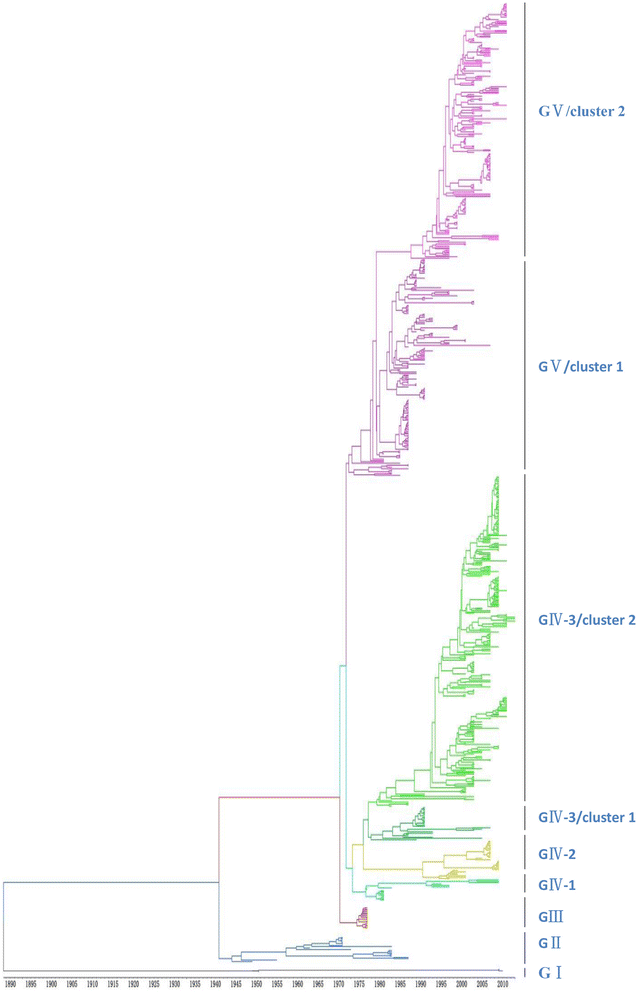
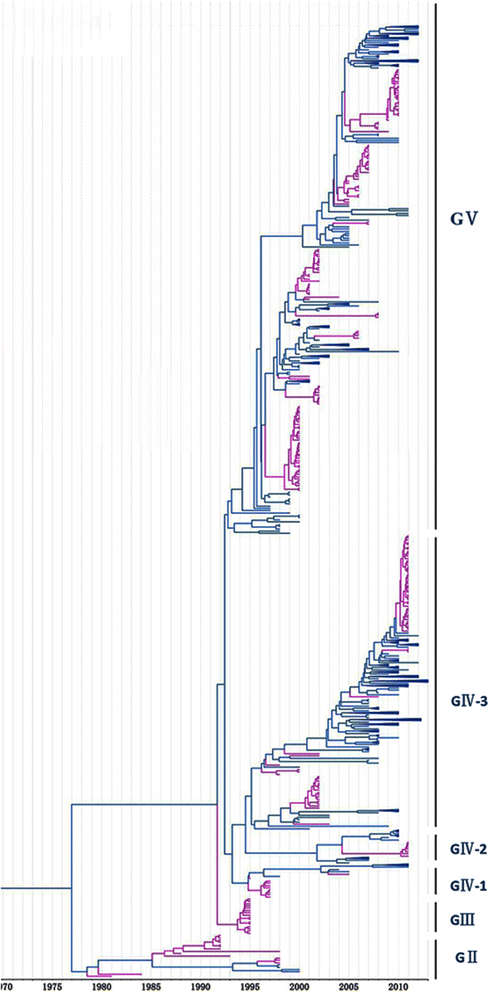
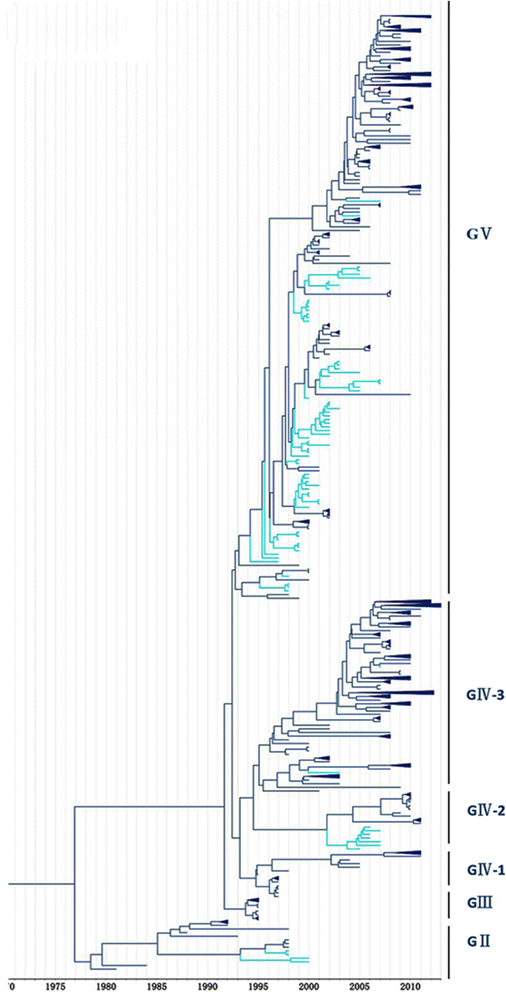

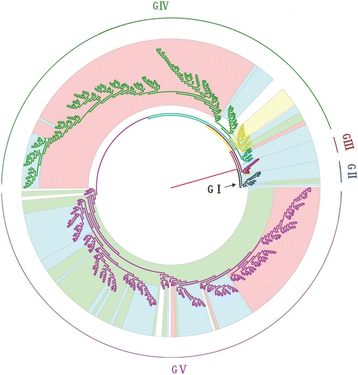
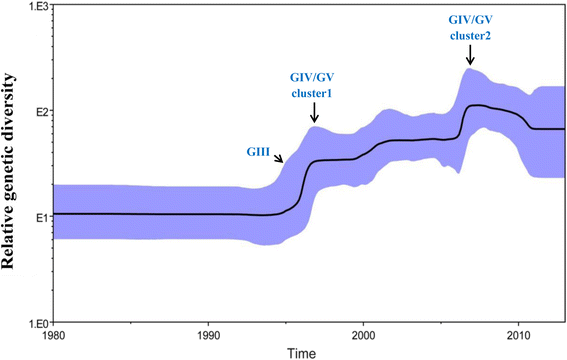
Similar articles
-
[Phylogenetic Analysis of the VP1 Region of Coxsackievirus A16 Strains Isolated in Anhui Province, 2014].Bing Du Xue Bao. 2015 Nov;31(6):660-4. Bing Du Xue Bao. 2015. PMID: 26951012 Chinese.
-
Epidemiological characterizations, pathogen spectrum and molecular characteristics of Coxsackievirus A16 from patients with HFMD in Yantai, Shandong, China between 2011 and 2015.Hum Vaccin Immunother. 2017 Aug 3;13(8):1831-1838. doi: 10.1080/21645515.2017.1318233. Epub 2017 May 24. Hum Vaccin Immunother. 2017. PMID: 28537484 Free PMC article.
-
Molecular surveillance of coxsackievirus A16 reveals the emergence of a new clade in mainland China.Arch Virol. 2019 Mar;164(3):867-874. doi: 10.1007/s00705-018-4112-3. Epub 2018 Nov 29. Arch Virol. 2019. PMID: 30498962
-
EV-A71 vaccine licensure: a first step for multivalent enterovirus vaccine to control HFMD and other severe diseases.Emerg Microbes Infect. 2016 Jul 20;5(7):e75. doi: 10.1038/emi.2016.73. Emerg Microbes Infect. 2016. PMID: 27436364 Free PMC article. Review.
-
[Research advances in molecular epidemiology and vaccines of Coxsackievirus A16].Bing Du Xue Bao. 2014 Jul;30(4):483-8. Bing Du Xue Bao. 2014. PMID: 25272607 Review. Chinese.
Cited by
-
Genetic Variation of Multiple Serotypes of Enteroviruses Associated with Hand, Foot and Mouth Disease in Southern China.Virol Sin. 2021 Feb;36(1):61-74. doi: 10.1007/s12250-020-00266-7. Epub 2020 Jul 28. Virol Sin. 2021. PMID: 32725479 Free PMC article.
-
An Environmental Surveillance in Uruguay Reveals the Presence of Highly Divergent Types of Human Enterovirus Species C and a High Frequency of Species A and B Types.Food Environ Virol. 2018 Dec;10(4):343-352. doi: 10.1007/s12560-018-9351-7. Epub 2018 Jun 16. Food Environ Virol. 2018. PMID: 29907902
-
Genome Analysis of Coxsackievirus A4 Isolates From Hand, Foot, and Mouth Disease Cases in Shandong, China.Front Microbiol. 2019 May 7;10:1001. doi: 10.3389/fmicb.2019.01001. eCollection 2019. Front Microbiol. 2019. PMID: 31134033 Free PMC article.
-
Molecular epidemiology of coxsackievirus A16 circulating in children in Beijing, China from 2010 to 2019.World J Pediatr. 2021 Oct;17(5):508-516. doi: 10.1007/s12519-021-00451-y. Epub 2021 Aug 28. World J Pediatr. 2021. PMID: 34453285 Free PMC article.
-
Genetic and Cross Neutralization Analyses of Coxsackievirus A16 Circulating in Taiwan from 1998 to 2021 Suggest Dominant Genotype B1 can Serve as Vaccine Candidate.Viruses. 2022 Oct 20;14(10):2306. doi: 10.3390/v14102306. Viruses. 2022. PMID: 36298861 Free PMC article.
References
-
- Shekhar K, Lye MS, Norlijah O, Ong F, Looi LM, Khuzaiah R, Marzuki I, Hussein I, Wong SL, Mohan J, et al. Deaths in children during an outbreak of hand, foot and mouth disease in Peninsular Malaysia--clinical and pathological characteristics. Med J Malaysia. 2005;60:297–304. - PubMed
-
- Tao ZX, Li Y, Wang HY, Song LZ, Liu GF, Liu Y, Lin XJ, Feng L, Yang H, Fan QY, Xu AQ. Genotype distribution of enterovirus A species isolated in Shandong Province, China. Bing Du Xue Bao. 2009;25:410–4. - PubMed
Publication types
MeSH terms
Substances
LinkOut - more resources
Full Text Sources
Other Literature Sources

